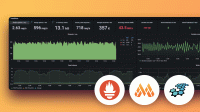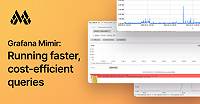This is documentation for the next version of Mimir. For the latest stable release, go to the latest version.
Grafana Mimir architecture
Grafana Mimir has a microservices-based architecture. The system has multiple horizontally scalable microservices that can run separately and in parallel. Grafana Mimir microservices are called components.
Grafana Mimir’s design compiles the code for all components into a single binary.
The -target parameter controls which component(s) that single binary will behave as.
To get started easily, run Grafana Mimir in monolithic mode with all components running simultaneously in one process, or in read-write mode, which groups components into read, write, and backend paths.
For more information, refer to Deployment modes.
Grafana Mimir components
Most components are stateless and do not require any data persisted between process restarts. Some components are stateful and rely on non-volatile storage to prevent data loss between process restarts. For details about each component, see its page in Components.
The write path
Ingesters receive incoming samples from the distributors. Each push request belongs to a tenant, and the ingester appends the received samples to the specific per-tenant TSDB that is stored on the local disk. The samples that are received are both kept in-memory and written to a write-ahead log (WAL). If the ingester abruptly terminates, the WAL can help to recover the in-memory series. The per-tenant TSDB is lazily created in each ingester as soon as the first samples are received for that tenant.
The in-memory samples are periodically flushed to disk, and the WAL is truncated, when a new TSDB block is created.
By default, this occurs every two hours.
Each newly created block is uploaded to long-term storage and kept in the ingester until the configured -blocks-storage.tsdb.retention-period expires.
This gives queriers and store-gateways enough time to discover the new block on the storage and download its index-header.
To effectively use the WAL, and to be able to recover the in-memory series if an ingester abruptly terminates, store the WAL to a persistent disk that can survive an ingester failure. For example, when running in the cloud, include an AWS EBS volume or a GCP Persistent Disk. If you are running the Grafana Mimir cluster in Kubernetes, you can use a StatefulSet with a persistent volume claim for the ingesters. The location on the filesystem where the WAL is stored is the same location where local TSDB blocks (compacted from head) are stored. The locations of the WAL and the local TSDB blocks cannot be decoupled.
For more information, refer to timeline of block uploads and Ingester.
Series sharding and replication
By default, each time series is replicated to three ingesters, and each ingester writes its own block to the long-term storage. The Compactor merges blocks from multiple ingesters into a single block, and removes duplicate samples. Blocks compaction significantly reduces storage utilization. For more information, refer to Compactor and Production tips.
The read path
Queries coming into Grafana Mimir arrive at the query-frontend. The query-frontend then splits queries over longer time ranges into multiple, smaller queries.
The query-frontend next checks the results cache. If the result of a query has been cached, the query-frontend returns the cached results. Queries that cannot be answered from the results cache are put into an in-memory queue within the query-frontend.
Note
If you run the optional query-scheduler component, the query-schedule maintains the queue instead of the query-frontend.
The queriers act as workers, pulling queries from the queue.
The queriers connect to the store-gateways and the ingesters to fetch all the data needed to execute a query. For more information about how the query is executed, refer to querier.
After the querier executes the query, it returns the results to the query-frontend for aggregation. The query-frontend then returns the aggregated results to the client.
The role of Prometheus
Prometheus instances scrape samples from various targets and push them to Grafana Mimir by using Prometheus’ remote write API.
The remote write API emits batched Snappy-compressed Protocol Buffer messages inside the body of an HTTP PUT request.
Mimir requires that each HTTP request has a header that specifies a tenant ID for the request. Request authentication and authorization are handled by an external reverse proxy.
Incoming samples (writes from Prometheus) are handled by the distributor, and incoming reads (PromQL queries) are handled by the query frontend.
Long-term storage
The Grafana Mimir storage format is based on Prometheus TSDB storage. The Grafana Mimir storage format stores each tenant’s time series into their own TSDB, which persists series to an on-disk block. By default, each block has a two-hour range. Each on-disk block directory contains an index file, a file containing metadata, and the time series chunks.
The TSDB block files contain samples for multiple series. The series inside the blocks are indexed by a per-block index, which indexes both metric names and labels to time series in the block files. Each series has its samples organized in chunks, which represent a specific time range of stored samples. Chunks may vary in length depending on specific configuration options and ingestion rate, usually storing around 120 samples per chunk.
Grafana Mimir requires any of the following object stores for the block files:
- Amazon S3
- Google Cloud Storage
- Microsoft Azure Storage
- OpenStack Swift
- Local Filesystem (single node only)
For more information, refer to configure object storage and configure metrics storage retention.



